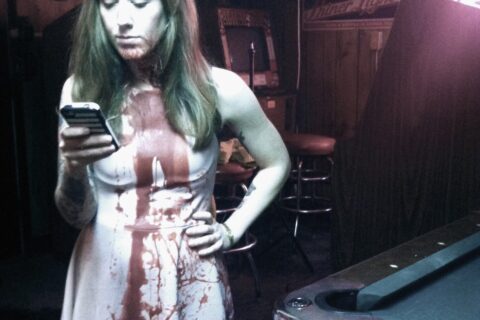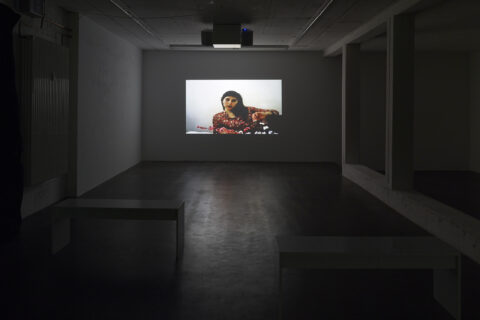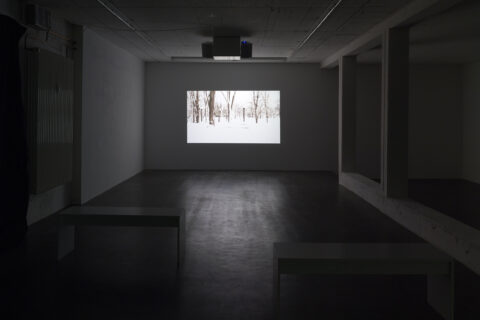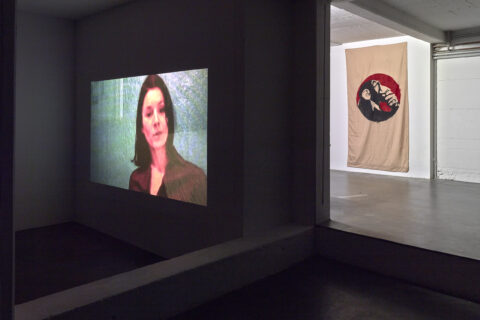Keren Cytter Siren
09/04/2014 – 30/04/2014
Preview: Dienstag, 08. April 2014, 18 Uhr
Galerie Nagel Draxler
An der Schanz 1 A
50735 Köln
Öffnungszeiten: Di-Fr 11-18 Uhr, Sa 11-16 Uhr
"Show Real Drama" - Performance von Keren Cytter im Kölnischen Kunstverein
Freitag, 11. April 2014, 18 Uhr
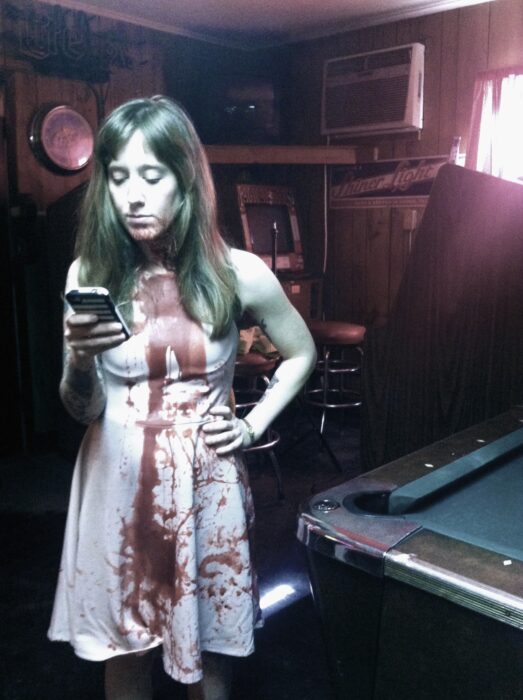
„SIREN“, 2014
Installationsansicht
Galerie Nagel Draxler, Köln
„SIREN“, 2014
Installationsansicht
Galerie Nagel Draxler, Köln
„SIREN“, 2014
Installationsansicht
Galerie Nagel Draxler, Köln
Press Release
Wir freuen uns, Ihnen neue Arbeiten von Keren Cytter präsentieren zu können. In ihrer Einzelausstellung, die wir am 08. April in Köln eröffnen, zeigen wir die neue Arbeit Siren zusammen mit dem "Klassiker" Les Ruissellements du Diable von 2008. Ausserdem ist zur Zeit, in der Münchner Villa Stuck, in der Gruppenausstellung "Der Stachel des Skorpions", Cytters neues Video Rose Garden zu sehen. Die Ausstellung geht anschließend an die Mathildenhöhe Darmstadt. Während der FILM COLOGNE, einer Sektion der diesjährigen ART COLOGNE, läuft Vengeance, das siebenteilige Videoepos, das nach Keren Cytters Umzug nach New York entstanden ist. New York ist auch das Setting dieses großen und wichtigen Projekts.
We are happy to present new works by Keren Cytter. On April 8th her solo exhibition opens in our Cologne gallery with her new work Siren that we will show together with one of her „classics“ Les Ruissellements du Diable from 2008. Keren Cytter’s video Rose Garden is presented in Villa Stuck in Munich in the group show „Der Stachel des Skorpions“, which will afterwards travel to Mathildenhöhe in Darmstadt. Vengeance, Cytter’s 7-episode video epic, that she developed after her relocation in New York, will be shown during FILM COLOGNE, a new section of this year‘s ART COLOGNE.
Siren, 2014 Digital HD video, color/sound 14:39 min
In Siren widmet sich Keren Cytter den "armen Bildern" und ihrer massenhaften Verarbeitung und Verbreitung durch Mobil- und Smartphonekameras mit Editing tools, Special Effects etc.. Die Erzählerin überzeugt einen männlichen Freund, im Namen aller Frauen und im Kampf gegen die Ungleichbehandlung der Geschlechter, einen Mord an einem anderen Mann zu begehen. Bilder und Szenen wiederholen sich in verscheidenen Qualitäten und Kontexten und führen die weite Bandbreite von Interpretationsmöglichkeiten vor Augen, die Bilder haben können.
In Siren Keren Cytter deals with "poor images" and their mass processing and circulation by mobile and smart phone cameras with editing tools, special effects etc. The female narrator convinces her male friend to murder another man in the name of all women and the unequal treatment in the battle of the sexes. Images and scenes are repeated in different qualities and contexts, showing the wide range of ambiguous possibilites of interpretation images can have.
Watch Siren on Vimeo: http://vimeo.com/87563491
Rose Garden, 2014 Digital HD video, color/sound 8:57 min
In einer texanischen Bar spielt sich eine tragische Geschichte ab. Der drastische Ablauf und die Leichtigkeit der Komposition stehen sich dabei kontrapunktische gegenüber. Durch das repetitive Einsetzen verschiedener Elemente (Titelmusik, wechselnde Atmospheren, Schüsse aus einem Gewehr), entsteht ein quasi musikalisches Arrangement. Die darin vorgeführte, nahezu emotionslose Akzeptanz des Todes, wird kontrastiert durch die Erzählstimme eines Vaters, der sich an seinen Sohn wendet. Rose Garden kritisiert gradlinig und präzise das bigotte Gemisch aus family values, American gun laws und allgemeinen gesellschaftlichen Verhaltensmustern.
A tragic story takes place in a Texan bar. Its drastic course and the lightness of the composition are opposing each other contrapuntally. A virtually musicial arrangement is formed by the repetitive employment of various elements (theme music, changing atmospheres, rifle shots). The therein presented, almost emotionless acceptance of death is contrasted by the narrative of a father speaking to his son. Rose Garden explicitely criticizes the bigot mixture of family values, American gun laws and societal behavioural patterns in general.
Watch Rose Garden on Vimeo: http://vimeo.com/87410422
Les Ruissellements du Diable, 2008 Digital video, color/sound 10 min
The film Les Ruissellements du Diable (literally "The whisper of the devil", 2008), is based on the short film of the Argentine filmmaker Julio Cortázar Las babes des Diablo (1958); another reference is the film Blowup by Michelangelo Antonioni shot in 1967 (again is based on Cortázar). The dialogues of the two main characters, a man and a woman, are not synchronized or don’t exist, while in-between the credits appear, confusing the viewer about the end of the film. The temporal discrepancy apparently obliterates all actual and fictional: the female protagonist is simultaneously an actor and TV presenter who stages her alter ego as an erotic fantasy. Alternating, the man and the woman tell the story, with the man speaking in the third-person singular and the woman in the first-person. Again and again a meeting in the park and an enlarged photo of this meeting take centre stage. The superimposed narrator characterizes the two translators as amateur photographers - thus people who work with language and image and who have the facility to change them in subtle ways. The metaphor of translation, whose specific set of problems is an important part of the film, is driven further in so far as the French dialogue is subtitled in English. Amidst all of these sounds and images appears a frontal close-up of a man masturbating. One might, like Skye Sherwin does in ArtReview, conclude that in “Les Ruissellement, reality is unstable, art the only certainty, solipsism unavoidable, and consequently masturbation the only thing that seems truly, graphically and physically" ‘real’.".
Watch Les Ruissellements du Diable on Vimeo: http://vimeo.com/77526396
Vengeance, 2012 Digital HD video, color/sound 7 Episodes à 15 min
For Vengeance, a seven-part video narrative epic, Cytter takes her own currently changing life situation as inspiration. Having recently moved to New York, Cytter adopted the US TV- platform of the “daily soap” as a structural format to processes classic themes of drama in personal relationships: love, envy, betrayal, and vengeance. Cytter’s characters perform exaggerated scenes of soap genre clichés, such as cheating on partners, and professions of love. Unlike her older series of video works and their intimate settings, the scenes in Vengeance were filmed at 15 different places around Staten Island and New Jersey, including restaurants, hotels, parks, apartments, and streets. A total of 50 actors, most of them professionals, fulfill their social functions with blank faces. They provide a projection space for the beliefs and stereotypes of each viewer.
Watch Vengeance (7 episodes) on Vimeo:
http://vimeo.com/80984502 / http://vimeo.com/80992404 / http://vimeo.com/81007720 / http://vimeo.com/76317351 /
http://vimeo.com/76508501 / http://vimeo.com/77032212 / http://vimeo.com/77392254
